Within Context of Germany [ Top ]
Locations & Maps [ Top ]
Photo map shows Wewelsfleth
on the Stör, with Uhrendorf up river. Use down arrow to see Borsfleth, then Glückstadt
to the south.
| Maps of towns in the Steinburg
district include Wewelsfleth
with nearby Borsfleth,
Beidenfleth,
Itzehoe,
with businesses identified by number. Uhrendorf is rural with no businesses. A map
shows the village of Uhrendorf on the Stör River to the east of Wewelsfleth with
Borsfleth and Ivenfleth to the south, across the Stör. This winding river is a tributary
of the Elbe
River.
Wewelsfleth is in the Wilstermarsch Amt or
collective municipality.
Wewelsfleth is in the Steinburg
district of Schleswig-Holstein. |
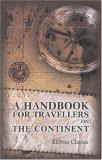
ORDER
A
Handbook for
Travellers on the
Continent: A Guide
to Holland, Belgium, Prussia,
Northern Germany,
and the Rhine
Reprint of 1860 Edition
|
Map
showing Wewelsfleth in relation to the Stör and Elbe rivers, Borsfleth, Itzehoe,
Glückstadt, Wilster, more
Towns north of Glückstadt
-- with distances -- include Beidenfleth,
Borsfleth,
Dammfleth, Hollerwettern,
Uhrendorf,
Wewelsfleth,
and south of Gluckstadt Deichreihe
near Kollmar.
And many more.
Interactive
satellite map with Glückstadt pinpointed on the Elbe River, other towns to
the north such as Ivenfleth, Borsfleth, Wewelsfleth,
Uhrendorf, Krempe, more. Agricultural fields are visible.
Maps
for Wewelsfleth and for towns and villages within 10 miles in any direction.
Choose M for Mapquest, G for Google Maps and more.
Map of the mouth of the Elbe
River up to Hamburg, showing Glückstadt, Wewelsfleth, Itzehoe, Wilster, and
Heide in Dithmarschen at the top, and more 1910 Baedeker maps of Northern
Germany
Map of the Elbe
River, highlighted in yellow, running from the Czech Republic across Germany
past Hamburg to the North Sea, and a map of the Elbe River, showing
land elevations on its course.
Map of the
Elbe River, North Sea to Hamburg, showing 13 nautical chart segments.
Enlarged map
has tributaries Stör, Krückau, Pinnau
Maps of
Schleswig-Holstein south of Denmark, with North Sea west, Baltic Sea east,
and Hamburg south on the Elbe River. Click to enlarge and see the Stör River north of
Gluckstadt. View a Schleswig-Holstein
interactive
map with Gluckstadt and Wewelsfleth near the bottom.
| Environment & Photos [ Top ] A photo
gallery for Wewelsfleth has 10 photos of ships, the shipyard, the yacht
basin, a lighthouse, the sky, the river and Holstein cattle grazing.
Peaceful Stör River
in winter & another view.
The Elbe
River marshes -- Wilster and Kremper located to the north and the south
of the Stör River -- were drained for farming, thanks in part to farmers from Holland
brought there to reclaim the land in the 16th century. See a detailed look at the
landscape of the area near Wewelsfleth. |
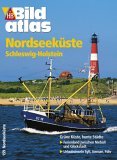
ORDER
Bildatlas
Nordseeküste / Schleswig- Holstein
Picture Atlas
North Sea Coast
|
Wilstermarsch
- a
photogallery showing 24 views between Glückstadt and Brunsbuettel with
windmills, churches, marsh with sheep, and more.
Wilster,
its old town
hall built in 1585, is at the heart of Wilstermarsch. Thatch-roofed cottages,
lush pastures and friendly people are typical.
Maps
of the Wilstermarsch and Krempermarsch
regions south of Southern Dithmarschen and north of the Elbe River, and of communities
including Gluckstadt, Borsfleth and Brunsbuettel. Unnamed, Wewelsfeth is the town area
shown just north of the confluence of Stör and Elbe rivers.
The Stör River, just 54 miles [87 km]
long, begins east of Neumünster. It flows through Itzehoe as shown on this map, also through
Wewelsfleth.
Winding Stör River and
terrain near Itzehoe, and a tour along the river in 22 photographs
from Arpsdorf at km14 through Kellinghusen km 32, Itzehoe km 53, Beidenfleth km 69 to
storm barrier km 80 and the Elbe.
Stör River
is the the largest right tributary of the Elbe River in Schleswig- Holstein. See picture
and interactive map of the river and tributaries such as the Krempau that flows
through Borsfleth and the Wilsterau
that flows through Wilster among them [in German].
Stör River tributaries, pictured, range from Der Aalbek to Die Krempau
that flows through Borsfleth to Die Schwale to Die Wilsterau.
See also the fish types
in the Stör [in German].
Stör
Storm Surge Barrier was inaugurated in 1975 to protect the Stör River
interior region during high water, with photos. Another view
plus one of the moveable
bridge that is part of the barrier.
Stör Hole
Borsfleth Yacht Club, with a view of the water, the flat terrain,
narrow strip fields, and the Stör River and surge barrier, in 5 photos.
Stör River once had rope-based
ferries or Seilfähre, but now just one, says this profile of
Beidenfleth, near Wewelsfleth. There Störkringel, an area favorite, is still baked,
a hard, pretzel-shaped
pastry.
Learn more about Beidenfleth
[in German] and Beidenfleth
[translated].
Die
Seilfähre or ferry in Wewelsfleth operated until 1976, just after the opening of
the storm surge barrier and its bridge.
Panoramas: Wintergarten
and Winter StraBe
near Wewelsfleth
Picture of Itzehoe
with its historic St.
Laurentii-Kirche or church and half-timber buildings plus modern structures.
More pictures for Itzehoe,
which is the county seat of Steinburg
Pictures and history for the Steinburg district include the town Krempe,
the town Wilster,
Glückstadt,
and a water-scooping-mill in Honigfleth.
Glückstadt:
click British flag for info in English, photos of town, river
Pictures of
Wilstermarsch: Elbe and Stör rivers, windmills and historic structures such as
Wewelsfleth's Die Fahrradscheune [Bicycle Barn]. See also the Wilster
old town hall.
Photos of the Elbe
at Kollmar south of Gluckstadt and near Deichreihe provide a vivid sense of the landscape.
Select the link Bildergalerie for panoramas of the region and photogalleries for
each month.
Maritime
Elbe River area tours include one starting at Ivenfleth, including Borsfleth
[See Der Gemüsetörn, tour 14], showing a photo
of Borsfleth church and an historic half-timbered house
Lighthouses
of the Elbe and Hamburg, including those of Gluckstadt, Wewelsfleth, more,
with photos including lighthouses and landscape.
Photo of the Kiel
Canal or the North Sea-Baltic Sea Canal, with the Elbe River in the
background and showing the countryside near Brunsbüttel, not far from Wewelsfleth. Learn
more about the Kiel
Canal.
The lower
Elbe River landscape shows its maritime heritage, with ships, old harbors,
warehouses, more. A look at the Elbe River.
Photo of icepack on the Elbe River near
Hamburg, January 2006, and a sunset at Hamburg
Harbour and photos of Elbe
River in Hamburg
Maps, weather
-- including temperature, cloud cover and precipitation -- plus nearby communities and
airports for Wewelsfleth
Weather
in Wewelsfleth, from Yahoo, and Wewelsfleth
weather
Culture, School, Language & Church [ Top ]
| Regional coats of arms and their symbolism reflect the
culture of farming and sailing. For Wewelsfleth
it is a farmhouse and a river sailing ship or ewer; for nearby Beidenfleth, it is
two sheaves of grain, a ship and river; for Steinburg, it is
three shields, three castle towers and water for the marshes and the Elbe River. However,
for Schleswig-Holstein
overall, there are two lions and a nettle-leaf, from Schleswig and Holstein coats of arms. |
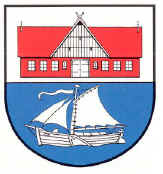
Wewelsfleth Coat of Arms
|
Grundschule
Wewelsfleth, the town's primary school with 130 pupils and the special
project featuring Common
School Magazine
Trinitatis
Kirke or Trinity Church in Wewelsfleth, with photographs of the lovely
interior and the exterior. It was built in 1503 A.D. Click the link Termine at left
to see dates of church and community events and contact names for organizations that
partner with the church on events. [Babel Fish translation. See German original],
Trinitatis Kirke home
page.
Pictures of 1698 Alfred-Döblin-Haus
in Wewelsfleth bought by Günter Grass, as well as the Gluckstadt harbor, typical marsh
region houses, other images from the Gluckstadt area. View of Alfred-Döblin-Haus.
| Low
German or Plattdeutsch is the spoken language of this area . Compare words in
English, Anglo-Saxon, Plattdeutsch and in Deutsch or German. Plattdeutsch was the lingua franca of
the Hanseatic traders in the Middle Ages who ranged from Scandinavia to northern Germany,
the Baltic region, Russia and England. Map
showing where Low
German is spoken, north of the Benrath Line [in red], and other map
showing Low German or Niederdeutsch as well as Middle and High German. |
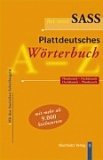
ORDER
Der
neue Sass. Plattdeutsches Wörterbuch.
|
Schleswig-Holstein
has the North-European tradition of adding -sen or -so(h)n to a father's name to make
surnames: Claussen, Petersohn, etc.
Cultural
monuments in Steinburg from Honigfleth to Beidenfleth to Glückstadt to
Wewelsfleth: city halls, churches, farmhouses, barns, windmills, more [in German]. The
house Günter Grass bought in 1970 was from 1859 the home of the Junge family, Wewelsleth
shipbuilders.
Typical
buildings and landscape in or near Brokdorf, Glückstadt and Wewelsfleth
are pictured [scroll down]. In addition, two varieties of the typical massive farmsteads
roofed with reeds [see Section 3.2 here]
are known as the Barghus, for example the Haubarg
in Eiderstedt, and the Husmannshus, such as this
one in Dammfleth, near Wewelsfleth.
Pictures and diagrams of the traditional hallenhaus, the
north German farmstead building encompassing the family home, stalls for cows and horses,
and the central hall for threshing or other activities. Variations
were known in the
region from Holland and Holstein to Prussia.
Das
niederdeutsches Hallenhaus had storage for hay and straw up under the roof
and stalls for cows along the edge. Eventurally the dwelling space for people was divided by walls from
the barn area.
The 1683
school building in Borsfleth
[in German] also shows the area's typical building style. Borsfleth is 1.8 miles
[2.9 km] from Wewelsfleth, across the Stör River as seen on this
map. More pictures of Borsfleth
with its traditional half-timbered houses, streets.
| Folk art,
pictured, from the Schleswig-Holstein art and culture museum includes a farmhouse room,
Borsfleth, Kremper Marsch, about 1750, and a piece of 19th century faience pottery from
nearby Kellinghusen. One picture of a Borsfleth
church, another of a Glückstadt market and a map showing these two towns and
Wewelsfleth.
A windmill from Borsfleth
[in German] is now at Der
Hessenpark, an open-air museum of the history and culture of Hesse, Germany. |
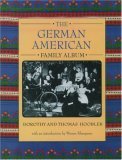
ORDER
The
German
American
Family Album
.
|
SPD
Wewelsfleth has a welcome from the burgomeister or mayor with town details,
the local
council and more. SPD is the social- democratic party of Germany. [Babel
Fish translation. See German
original]
Volunteer
Fire Brigade in Wewelsfleth, with photos
Die Fahrradscheune
or the Bicycle Barn in Wewelsfleth -- a beautiful barn with historic bicycles
such as a velocipede (1870) and high wheeler (1880). Pictures including one of the barn with
bicycles, and a photo of one of the historic
bicycles. [All sites in German].
Drachenfeste
Wewelsfleth, or Kite Fest, and more photos.
Stör River news shows the Störschipperfest in 2007 with
traditional river transport ships or ewers, the moving of the ship or Störewer
"Hermann," the 2006 launch of the new rope-ferry Else at Beidenfleth and
flooding on the Stör River near Kellinghusen in 2004.
Weinkontor
or wine bar in the heart of Wewelsfleth, with directions from Hamburg or Husum [in
German].
Land Hotel
Lüders, Wewelsfleth, is located in a specialized hall typical for the
Wilstermarsch and its restaurant offers regional food specialties. Another view plus Cafe Uhrendorf [in
German].
Agriculture, Food & Industry [ Top ]
History of
Agriculture includes the history of farming in Germany and the influence of
Holland on north German agriculture and dairy farming, especially after 1550. Britannica,
104 pages.
In the 1600s, Anabaptists from the Low Countries are said to have
introduced dairy
farming in southwest Holstein near Wewelsfleth.
The famous black and white dairy cow known as the Holstein
or the Holstein-Friesian, originated in northern areas of the Netherlands.
Gardens
of village families included vegetables, fruits, herbs and on occasion flowers. In
northern Europe as early as 1500, foods grown included kale and cabbage,
peas, leeks, onions, garlic, sage and other herbs, and strawberries, apples, cherries and
plums.
Potatoes
were first grown in Germany in 1620. Widespread cultivation only occurred by the late
1700s.
Food dishes of Schleswig-Holstein are shaped by fisheries and the
dairy industry. A typical
dish is a soup of kale with sausages and potatoes. Others: Old German potato soup,
kale and pork
chops, more.
Schleswig-Holstein has a tourists' cheese route
for sampling.
| Northern
German recipes: various soups, stews, Holstein sauerbraten, numerous dishes
with pork, veal, fowl or fish, pancakes and desserts, as well as old recipes from North Germany
taken by immigrants to Iowa German
cuisine is known for meat, sausage, and cheese. Potatoes, sugar and
rice were widely available by the 1700s. Horseradish and mustard are noted condiments.
Pumpernickel bread is from Northern Germany, its foods influenced by Scandinavia.
Recipes are provided. |

ORDER
Germany's
Regional
Recipes
.
|
German
cuisine is outlined, with regional specialties given such as aalsuppe and labskaus from the Hamburg
area
Pork
and beer, favored by ancient Gauls, are still important in German
cuisine, which is also influenced by religion and region, the south being typically
Catholic, the north Protestant.
| History of
shipping [pdf] and shipbuilding in the lower Elbe River, with a focus on Wischhafen,
a town located on the left or south side of the river, across from the city of Glückstadt,
and on ewers or flat- bottomed transport lighters The harbor at Glückstadt
in the 1880s, filled with sailing ships of various kinds, and other photographs, including
an aerial view of
the city and the herring
fishing fleet that operated for 100 years. |
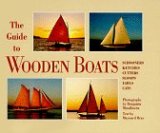
ORDER
The Guide to Wooden
Boats: Schooners,
Ketches, Cutters,
Sloops, Yawls, Cats
|
The J. Junge
Shipyard of Wewelsfleth once built small ships, including the flat- bottomed Anna
constructed in 1910 to transport foodstuffs, peat and coal on the Lower Elbe. Anna [in
German] with photo.
Johanne,
formerly called Meteor, and the Berta
are other river vessels or ewers built at the J. Junge shipyard, Wewelsfleth, 1905 and
1910. As early as 1875, the Johann Junge shipyard was the first to build a new model of ewer
for use as fishing ships [in German] . See photos of models of these Besanewers
from the Johann
Junge shipyard.
Ship Hermann
built in 1905 at shipyard of Claus Witt, Wewelsfleth, one of some 1,000 ewers or river vessels
that carried goods to Hamburg.
| Die
Peterswerft und ihre Schiffe: this book is the history of Wewelsfleth shipyards
such as von Harm Stelling (1800-1871), Johann Junge (1859-1918), Marcus Saß (1860-1868),
Johann Hein (1868-1887), Jürgen Peters (1871-1907) and Claus Witt (1900-1918) Peters Schiffbau [in
English or German] is the key ship building and repair business today. The shipyard
and town are pictured, and the history
of shipbuilding in Wewelsfleth from 1757 is told. At one time four shipyards existing
side-by-side in the town. Driving
from Hamburg to the shipyard is a journey through small towns. |
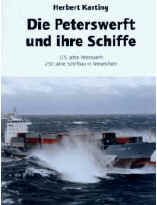
Order from Germany
Peterswerft
and their ships. 125 years of Peterswerft,
250 years of shipbuilding
in Wewelsfleth
|
A profile of Peters
Schiffbau notes that in its early days it built wooden vessels that were
herring luggers, pilot boats, galleasses [fighting ships], and kuffs [two–masted
freight sailing vessels].
An interview
with a worker at the Wewelsfleth Dockyard, by students
A few of the many vessels built at the Peters shipyard in
Wewelsfleth are:
· Cuxhaven,
pilot schooner built in 1901, now the Atalanta, also here
· Warturm,
1968, anchor-handling tug supplier
· Sinbad,
1981, and Polarwind,
1983, cargo vessel; Elisia,
1984,
multipurpose, and container vessels Freesia,
1983, and Tertia,
1985, and Ida,
1986, shown discharging timber.
· Cargo
ships Fri Sun, 1980; Fri Sky, 1981; and Fri Star, 1981
· Fehn
Moon, 1990; 23
more hard-working ships; Patriot,
1994; and
Frieda,
1995
Kusch Yachts,
founded by Claus Kusch, has been building mega yachts in Wewelsfleth for 25 years. Jan C. Wolf worked
awhile.
People & Genealogy [ Top ]
Christian
Stengel, full name Otto
Christian Stengel, was born March 3, 1795, in Wewelsfleth. He had a 60-year
career as doctor to the mining district of Røros, Norway. He has descendants
in America.
Carsten
Conrad Kohrs was born in 1835 in
Wewelsfleth, a fishing village in Holstein and left in 1850 for a life of adventure. He
became a U.S. citizen in 1857, built a cattle empire and was Montana's Cattle King.
Tthe National Park Service today runs the Grant-Kohrs
ranch near Deer Lodge, Montana, as a National Historic Site Johann H. L. Kohrs,
his brother, settled in Iowa and ran a pork packing business.
| Dettleff
Kracht, born about 1805 in Wewelsfleth, came to America and settled about
1838 in Millstadt, Illinois, where he was one of many German settlers. Peter
Egge married Elsabe Wilkens in 1820 in Wewelsfleth, Holstein, Germany and
they had five children including Heinrich Egge,
born 1830 in Wewelsfleth, the latter coming to Nebraska, then marrying and also having
five children.
Conrad
Banck and Gretje Behrens were married in 1846 in Wewelfleth's Trinitatis
Church, and their sons John and Henry were baptized there. The sons came to America in
1868.
Johann P.
G. Strenge born 1865 in Wewelsfleth, Holstein, Germany
Some
surnames found in Schleswig-Holstein locations -- including Borsfleth,
Itzehoe, Neuenkirchen, and Wewelsfleth -- are listed, all of which are Evangelical
Lutheran. Wewelsfleth surnames include Albers, Brandt, Ehlers, Hein, Hellmann,
Hoffmann, Schmidt and Wessel.
Genealogy Work
Group for Schleswig-Holstein with emigrees, census transcriptions such as the
1803 census for Wewelsfleth
with Tonner and Suhr families, many more |

ORDER
Finding Your
German Ancestors:
A Beginner's Guide
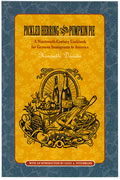
ORDER
Pickled Herring and Pumpkin Pie: A Nineteenth-Century Cookbook
for German Immigrants to America
|
Lutheran
Church parish records for southern Schleswig-Holstein, noting that
Wewelsfleth records go back to 1650.
Population
of Wewelsfleth and other towns north of the Elbe River, in the left column, with small
number and percentage who are Catholic
Wewelsfleth
page in We Relate Genealogy site, to be developed
Schleswig-Holstein
Genealogy including a large emigrant database, a timeline of the complex
history of this area fought over by Denmark and Germany, maps, towns, names, more
Schleswig-Holstein
Genealogy including those who emigrated abroad to America and elsewhere
New Holstein:
this town in Calumet County, Wisconsin,
was settled by Germans from Schleswig-Holstein, but especially locations in Holstein.
Among them was Cecilia Tonner Boie, born December 3, 1830, in Wewelsfleth, the daughter of
Claus Tonner and Margaretha Suhr who married there on July 7, 1828. All of their children
emigrated to America, and Claus himself came in 1874.